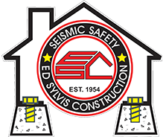The health and structural stability of your foundation play a huge role in every other aspect of your home, all the way up to the very tip of your roof.
A solid foundation is a sign of a solid home and a smart purchase, just the same way that a shaky foundation is a surefire sign of a shaky home and a purchase you need to be cautious about – or at least get into with both eyes open.
This is why it’s so important to have a proper foundation assessment conducted by legitimate experts (like the team at Seismic Safety) so that you know exactly what you are getting into.
Thorough inspections of the foundation will let the buyer and seller of a property move forward with a lot more confidence.
Foundation Crack Trouble
Not all foundation cracks are created equal, but it’s not a great sign to see cracks forming along any part of your foundation or crawlspace walls (or the floors, for that matter).
Structural cracks could significantly weaken the foundation structure, and that’s going to impact your walls, your floors, and your roof – sometimes just a little, but (more often than not) much more than you would expect.
Expert foundation assessors can quickly tell which cracks are the most serious, the root causes behind those cracks forming, and the best approach to resolve these issues without having to spend a lot of money or take a lot of time.
Moisture in Basement and Crawlspace Areas
Even though many basements and crawl spaces eventually become at least a little damp (if not outright moist) spaces, they are supposed to be as bone dry as it gets.
Signs of water intrusion – even just a bit of moisture and dampness – are signs that something has gone wrong with your foundation.
More often than not water has found its way through a crack in your foundation, but sometimes the moisture comes from hydrostatic pressure built up in the soil around your foundation walls.
At the end of the day, though, it’s important to get out ahead of these moisture problems before they become much more expensive issues to resolve.
Solutions like applying Xypex to your walls (crystallizing moisture upon contact) can be recommended to seal that moisture out and return your basement/crawlspace to its intended bone-dry condition.
Concrete Crumbling
You don’t have to be a professional foundation assessor to understand that crumbling concrete on a foundation or crawlspace is a dangerous sign.
Sometimes concrete crumbling happens because of exposure to excessive moisture. Sometimes substandard materials were used in the foundation building process. Let’s not forget that you might be you’re dealing with a physically damaged foundation (hit with equipment, struck by a car, penetrated by tree roots, crumbling due to seismic activity, etc.).
No matter the root cause issue, though, crumbling concrete has to be addressed ASAP. This is something that threatens the structural integrity of the rest of your home. It’s not something that can be put off and will almost always cause a home inspection to fail.
You might even need to invest in seismic retrofit solutions (like an earthquake brace bolt system) to shore up and secure your foundation. A detailed inspection and assessment will tell you the best course of action!
Conclusion
As you can see, a lot more goes into a proper foundation assessment than just walking around the walls of your basement or crawlspace and doing a visual inspection.
If you’d like real experts to assess and report back about the health of your foundation – including details regarding problematic areas, areas that should undergo the best fountain repair Los Angeles has to offer or replaced completely, and more – don’t hesitate to contact us here at Seismic Safety today.
We’re happy to help!

